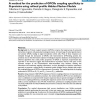234 search results - page 38 / 47 » A Simple Statistical Algorithm for Biological Sequence Compr... |
TKDE
2008
13 years 7 months ago
2008
Given a large spatio-temporal database of events, where each event consists of the fields event ID, time, location, and event type, mining spatio-temporal sequential patterns ident...
RECOMB
2009
Springer
14 years 8 months ago
2009
Springer
The combination of fully sequence genomes and new technologies for high density arrays and ultra-rapid sequencing enables the mapping of generegulatory and epigenetics marks on a g...
BMCBI
2007
2007
FUNC: a package for detecting significant associations between gene sets and ontological annotations
13 years 7 months ago
Background: Genome-wide expression, sequence and association studies typically yield large sets of gene candidates, which must then be further analysed and interpreted. Informatio...
BMCBI
2005
13 years 7 months ago
2005
Background: G- Protein coupled receptors (GPCRs) comprise the largest group of eukaryotic cell surface receptors with great pharmacological interest. A broad range of native ligan...
ICML
2008
IEEE
14 years 8 months ago
2008
IEEE
Residual gradient (RG) was proposed as an alternative to TD(0) for policy evaluation when function approximation is used, but there exists little formal analysis comparing them ex...

